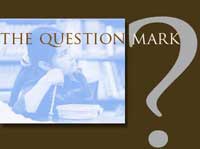| Research Cycle |
Order Kindle versions of Jamie's books
Order Jamie's books online with Paypal or a credit card
|
|
|
| Vol 11|No3|February |2015 | |
Blue Sky Thinkingby Jamie McKenzie (about author)
© 2014, Jamie McKenzie Without hope, there is little hope. We expect the young to make this a better world - to dream, to aspire and to reach for the stars. Langston Hughes once spoke of dreams in a manner that has great significance for this generation . . .
Blue sky thinking is a blend of optimism, hope, skill and wonderment that can lead to invention and positive change. For those who are familiar with Costa and Kallick's 16 Habits of Mind, blue sky thinking can be seen as a blend of several of their habits. It is both an attitude and a set of skills that can be nurtured by good teaching.
But those five do not quite capture the optimism, faith and wistful attitude usually involved in blue sky thinking. Many dictionaries have an almost scornful attitude toward blue sky thinking, dismissing it as impractical (not adapted for use or action; not sensible or realistic). Here are some examples:
Blue Sky Thinking in the CurriculumOptimistic thinking should be a central goal of schooling. Analytical and logical thought is well and good, but the culture suffers when problem-solving is constrained by an overly practical or pessimistic view of possibilities. One need only look at the often misguided "reform" efforts that have been imposed on schools globally, often driven by corporate and political interests that seek to implement factory-style learning approaches that rely upon standardization and mechanistic strategies. The curriculum narrows and the classroom focus shifts from learning to testing. The test reigns supreme. Concrete ExamplesProblem-based learning is a promising way to engage students in optimistic planning. PBL challenges students to come up with satisfying solutions to authentic problems and issues from the environment and the society. Students are charged with doing more than studying these issues. They explore root causes, look at past efforts to address the problem and then propose action plans that might make a real difference.
These are problems that have baffled and frustrated the adults for decades. Trained by the best universities in logical analysis and management, adult leaders rarely come up with action plans that make much difference. The above list would have served well for a similar article in 1990. Twenty-five years later, the practical efforts of politicians and leaders have hardly dented the problems. Many citizens of New Orleans suffered the consequences of this failure because the disaster planners responsible for protecting them from Katrina were unable to create effective plans to prevent the collapse of levies and the stranding of poor people. Evacuation required transportation resources like cars not available to the urban poor. The city told them to leave their homes and gather in the football stadium but plans for feeding, housing, policing and treating the medical needs of thousands of refugees were woefully inadequate. Ironically, disaster planning requires the dark side of blue sky thinking. Anticipating the worst that could happen leads to plans that protect folks. The worst and the best are partners in the planning process. In 2000 I published an article, "Beyond Information Power" that seems timely fifteen years later, as it stressed the importance of fresh solutions to old problems.
Blue sky thinking is the key to moving the society and the civilization forward. We sorely need a generation of students with a change ethic.
Whether you call it problem-based learning, project-based learning, engaged learning or constructivist learning, our students will only come to thrive in this new information landscape if we engage them frequently in challenges calling for fresh thought. When we involve students in suggesting ways to better their community or tackle a nagging social or environmental problem, we are asking them to perform synthesis at the highest level. It is not sufficient for them to study the problem or describe the problem. It is not enough to cut and paste the thinking of the sages. In many of these cases, the sages and the elders have failed, so it is incumbent upon the students to "do a better job" and add value to the action plans of the past.
The alternative is unthinkable . . .
Blue Sky Thinking Returning to the box Blue © Jamie McKenzie Copyright Policy: Materials published in The Question Mark may be duplicated in hard copy format if unchanged in format and content for educational, nonprofit school district and university use only and may also be sent from person to person by email. This copyright statement must be included. All other uses, transmissions and duplications are prohibited unless permission is granted expressly. Showing these pages remotely through frames is not permitted. FNO Press is applying for formal copyright registration for articles.
|


